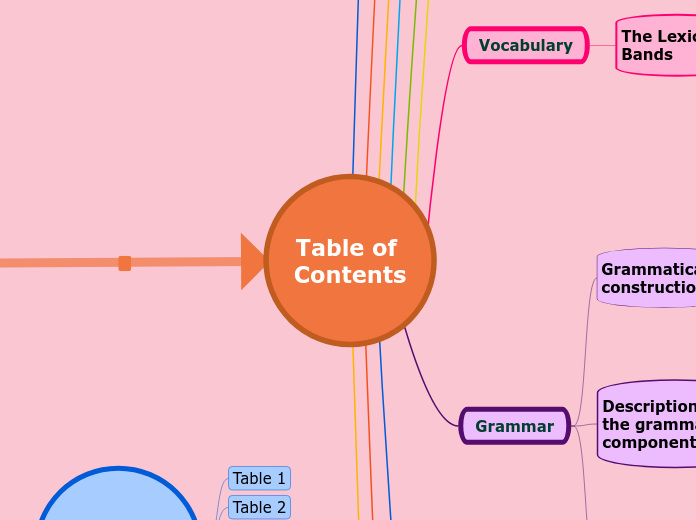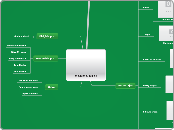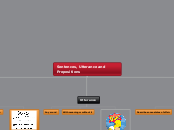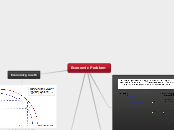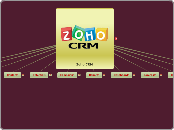الاسم: رؤى حاج يحيى
* تخطيط خريطة عقل (خريطة ذهنية) توضح جميع مركبات المنهاج الجديد في اللغة الإنجليزية ومركباتها الفرعية بحيث تظهر خريطة العقل مدى فهمك للمنهاج.
English Curriculum 2020
For Junior High School
List of Figures
List of Tables
Table of Contents
References
National Institute for Testing and Evaluation. (2016). Common European Framework of
Reference for Languages (CEFR) Hebrew Version. NITE, Israel
Kitao, K. (1996). Why do we teach English? The Internet TESL Journal, 2(4), 1-3.
http://iteslj.org/Articles/Kitao-WhyTeach.html
Israel Ministry of Education (forthcoming). Guidelines for the Teaching of Englishat the PreFoundation Level. Pedagogical Secretariat, Ministry of Education.
http://meyda.education.gov.il/files/Mazkirut_Pedagogit/English/prefoundationcando.pdf
Israel Ministry of Education (2018). Revised English Curriculum. Pedagogical Secretariat,
Ministry of Education.
http://meyda.education.gov.il/files/HaarachatOvdeyHoraa/Englishcurriculum.pdf
ECOSTAR. (2017). CEFR-Aligned Framework for English in Higher Education in Israel.
https://tempus-ecostar.iucc.ac.il/wp-content/uploads/2016/04/FRAMEWORK-ATARwith-preface.pdf
Crystal, D. (2003). The Cambridge Encyclopedia of the English Language. Cambridge
University Press.
Council of Europe (2018). Common European Framework of Reference for Languages:
Learning, Teaching, Assessment. Companion Volume with New Descriptors. Council of
Europe. https://rm.coe.int/cefr-companion-volume-with-new-descriptors2018/1680787989
Council of Europe (2011). Common European Framework of Reference for Languages:
Learning, Teaching, Assessment. Council of Europe.
https://www.coe.int/en/web/language-policy/home?e1_en.asp
Byram, M. & Parmenter L. (Eds.) (2012). The Common European Framework of Reference: The
globalization of language education policy. Multilingual Matters.
Alsagoff, L. (2012). Principles and practices for teaching English as an international language.
New York: Routledge.
Global Can-do Statements
Basic User II- A2
Can-do descriptors
Adjective /adverb forms
Noun Forms
Verb forms
Clauses
Table 6
9th Grade
8th Grade
7th Grade
Plurilingual and pluricultural competence
Spoken fluency
Pragmatic
Sociolinguistic
Orthographic control
Phonological control
Linguistic
Activities
Written interaction
Spoken interaction
Spoken production
Spoken reception
Format of the grammar component
Figure 2
Examples
Operative can-do statement
Global can-do statement
Structure
Description of the grammar component
Grammar development
Evolving usage and accuracy
Emerging production
Mostly receptive
Grammatical constructions
Use in terms of pragmatic appropriacy
Meaning
Structure or form
The Lexical Bands
Table 5
Independent User II
Independent User I
Basic User II
Basic User I
Pre-basic User
Table 4
Grade Level
Lexical Band
Level
Sources for Can-do Statements and Format of Presentation
Format of Presentation
Figure 1
Source
Activity
Sources
(GEPF)
(AUS)
(GSE)
CEFR
Levels of Progression
Table 3
Revised English Curriculum 2018
CEFR Global Scale
English Curriculum 2020
Principles to Guide Teaching Practice
F. Principles underlying the integration of ICT
E. Principles underlying classroom assessment
D. Principles underlying the design of tasks
C. Principles underlying the selection of materials
B. Principles underlying beginning language learning and teaching
Table 2
A. Principles underlying language learning and language teaching
Table 1
Curriculum Components
Grammar
a lists of structures
Vocabulary
words and chunks
bands
Domains
Personal domain
Public domain
Occupational domain
Educational domain
Can-do Statements
Operative
Global
interdependent dimensions
Communicative Competences
Pragmatics
Sociolinguistic competence
Linguistic competence
phonological and orthographic control.
grammatical accuracy phonological and
orthographic control.
vocabulary size and depth
General linguistic range
Language activities
Mediation
Interaction
Production
Written production
Oral production
Reception
Written reception
Oral reception
Alignment with the (CEFR)
Introduction
